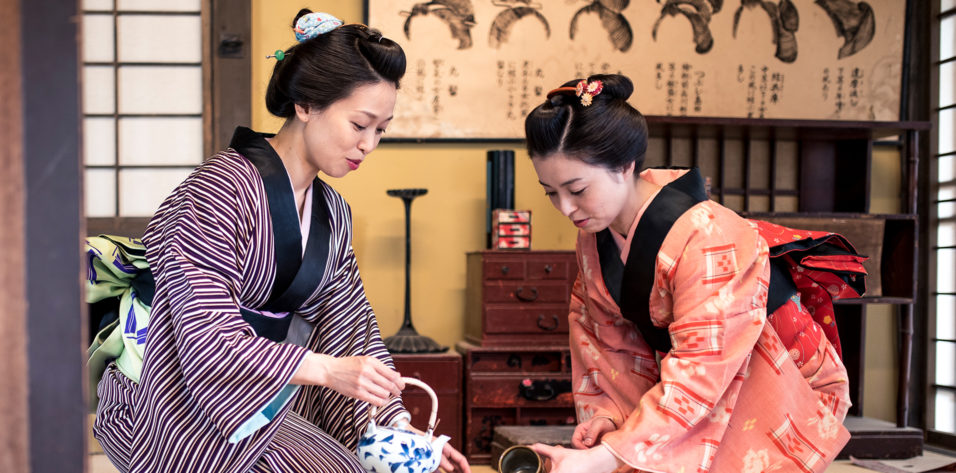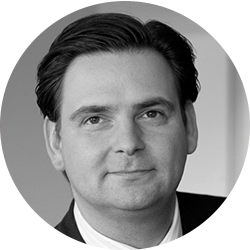
Detlev R.H. Breyer, MD
Building Blocks of Success
Achieving a successful surgical experience for both the patient and the surgeon is a multifactorial undertaking. All components must work harmoniously to create a positive atmosphere in the operating room (OR) and ensure optimal outcomes. In my practice, the main building blocks are as follows:
Personalized patient reception. The receptionist should recognize the patient and guide him or her to a patient manager who takes individualized care of the patient.
Visible quality. Quality management and hygienic standards should be visible to the patient to calm any potential fears or concerns.
A top-notch anesthesiologist. A friendly, empathetic anesthesiologist can wipe away the patient’s fear of pain. The patient can choose his or her type of anesthesia procedure.
A patient-centric environment. A quiet and professional atmosphere in the OR is key. Banter and private talk among staff members should be avoided, unless the patient initiates this kind of conversation. Overall, the OR environment should be pleasant and relaxed.
An A-Team. The surgical staff should consist of well-educated employees with positive problem-solving attitudes.
In addition to these practices, I observe a few personal presurgery rituals to promote my own success. These include yoga and a morning walk along the Rhine River and through a park to my clinic, during which I aim to focus my mind and get into a good mood. Finally, at the end of the session, if I know I have a tough case coming up on the next surgery day, I schedule with the anesthesiologist for it to be done under general anesthesia, after consulting with a friend of mine, another good surgeon, to double-check my strategy.


Günther Grabner, MD
Habits for Success
Over the course of my surgical career, I have discovered three habits that I believe contribute to my success in the OR. First, I drink a cup of green tea in the morning before surgery. Second, before I have scrubbed for each case, I stick my head in the OR and ask the nurses, “Patient ready, can I come?” The answer is always, “We are ready if you are.” Third and last, when faced with a tough case, I mentally go through all of the surgical steps immediately before I start, in order to help ensure that I complete the procedure as precisely and expeditiously as possible.

Arun C. Gulani, MD
Visualizing Success
I live by my personal adage: “No case is complex, every case is unique, and, by those virtues, no case is routine.” Most of the patients I operate on are referred to me due to their case’s complexity or complications. Therefore, I approach every patient as unique so that there is no notion of routine or complexity in my mind. Given that many of my patients are surgeons, pilots, athletes, and others with high visual demands, this decreases anxiety, as my focus on each patient’s surgery is equally intense no matter how distinct, important, or difficult the case may be—my focus being the vision endpoint.
I encourage surgeons to think of themselves as chefs who, instead of belting out burgers and hot dogs on a conveyor belt (ie, performing cookie-cutter surgery), actually design a meal for every patient to his or her utmost satisfaction. You need to be focused on the taste, presentation, and aroma of the final dish; therefore, the process of getting there (ie, the cooking) is, in fact, more intense, as any mistake you make could deprive you of the goal you and your patients set.
With this analogy in mind, I visualize each patient’s success. When I do this, the surgery becomes an avenue for me to use the necessary technologies and techniques to manipulate the patient’s optics to design his or her best vision.
My surgical process to promote success is as follows:
Meeting the patient. When a patient and/or his or her referring surgeon contacts my practice for a complication or complex case repair, we usually arrange for a teleconference, at no charge. This way, our relationship with the patient begins with a clear understanding of my philosophies and concepts even before the patient travels to our practice. We do not advertise, use discounts, or rely on hype to bring in patients, so it is ethically important to me that patients do not spend money traveling to see us with improper expectations or hopes.
Prioritizing accuracy. The weekend before the patient arrives in Jacksonville, Florida, for surgery in the coming week, I prepare for the procedure by performing extensive calculations, planning my surgical approaches, and selecting the appropriate technologies for the individual case. By the time the patient arrives at the OR for surgery, I have typically seen and personally evaluated him or her two or three times; therefore, a rapport between us already exists, and my intense desire for accuracy in measurements and clarity of plan and expectations has been established.
My toric tolerance is zero; hence, I mark every patient at the slit lamp before surgery, which gives me an opportunity to once again review my surgical plan. Additionally, if I am working on a patient’s second eye, at this encounter I can look at the first eye and confirm success.
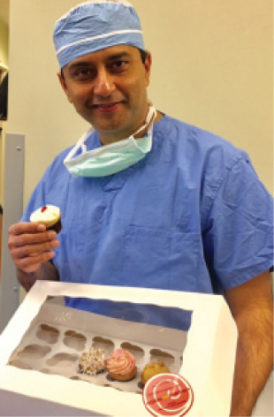
Courtesy of Arun C. Gulani, MD
Timing indulgences. The evening before a surgery day, I do not lift weights in the gym, and, if I attend any social gatherings, I refrain from drinking my favorite single malt. My surgical staff is well aware of my love/penchant for chocolate and ice cream, but, on the mornings of my surgery days, I do not indulge in any sweets or coffee. The end of my surgery day is a different picture: It is not uncommon to find me with a box of candy, cupcakes, or ice cream; many times, I share these treats with my patients.
Detailing the case. Before surgery, I meet with all surgical staff members to ensure that they are aware of each case and the patient’s specific situation. This is especially important when operating at a common ambulatory surgery center (ASC), for example, for cataract surgery. At the common ASC I use, a procedure may be labeled cataract surgery with toric IOL; this is misleading in most of my cases, as it does not indicate the level of difficulty or potential complexities, such as a history of previous surgery, small pupils, subluxated lenses, or a monocular patient. It is important to communicate these details to the staff.
Zoning out. During surgery, I zone out completely. In my OR, there are no cell phone calls and no outside world news. I do update the patient, however. For example, because I do a number of post-RK cataract surgery cases, I let the patient know that I have decided to stand and operate from his or her nasal side, so he or she may feel my hand on that side of his or her face. (In postoperative feedback, patients report that they appreciate getting such information.)
No patient on my surgery day can be rushed. At my institute, everything runs on time; but, at the shared ASC, sometimes the cases before mine are behind schedule. In this situation, I maintain my composure by creating a mental fortress around myself and my patient, which helps the staff to maintain a no-stress, no-rush environment.
Personalizing care. I always visit with the patient and his or her family members before surgery. After the procedure is complete and before the next case, I walk out of the OR and meet with the family members to let them know how everything went.
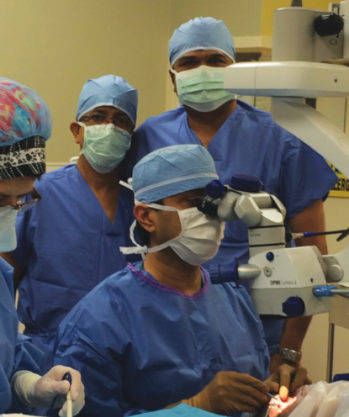
Courtesy of Arun C. Gulani, MD
One more important caveat: I insist that every surgeon learn to visualize each patient’s face while working on that patient’s eye. This takes away the possibility of casually giving up in the face of difficulty, taking wrong steps, or having a cavalier attitude. Eye surgery can affect that patient for life through the decisions we surgeons make in minutes.
I tell surgeons to imagine being that patient and what you would want from your surgeon. You would not want your surgeon to worry about his or her personal life, the stock market, or even the next case while he or she is in your eye. I regularly see patients who are angry after surgeries in which their surgeon tried to perform surgical acrobatics but ended with functional failure (poor vision endpoint). I remind surgeons that patients do not really want surgery; they want vision. Our goal is to not lose any visual potential and to always be mindful of that.
By this token, surgeons should also not forget to celebrate and enjoy their patients’ outcomes. Surgeon who do not get to see his or her product after surgery miss out on this wonderful reward.
Although I often host visiting surgeons, my primary focus is always on the patient. I review each step with my colleagues after surgery or record the surgery for them, but my plan is for the entire system of surgeon, patient, observing doctors, relatives, and nursing staff to be focused on the patient. That way, patients can rest assured that the environment around them is completely controlled, with all the proper parameters in place. Then, the surgeon can look forward to changing lives and finish his or her surgery days feeling exhausted but exhilarated.
Overall, my so-called lucky charm in the OR is my visualization of each patient’s visual success, no matter how complex the case may be.
And I always say to visiting surgeons: “Your hands cannot perform what your heart has not decided.”
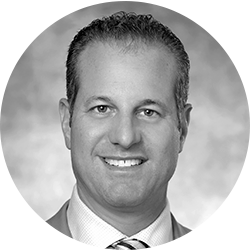
Mitchell A. Jackson, MD
OR Rituals—Dr. Jackson Style
The Merriam-Webster dictionary defines a ritual as “an act or series of acts regularly repeated in a set precise manner.” Most eye surgeons are somewhat obsessive-compulsive, operating as we do in a space less than 7 mm3 most of the time. To be that precise, for the past 24 years in private practice, my surgery days have been quite ritualistic, from the setup, to the experience itself, to the final close.
For the setup, I visit the local Lake Villa diner in the morning, around 6 AM, and eat breakfast with the same core group of locals (each of whom I have operated on in the past, and all of whom are over the age of 70 years). Here, we simply get caught up on life—and believe me, they have Samsung tablets and iPhones and probably make me look outdated. They always buy my breakfast on surgery day, but I always maintain a balanced budget with them in the end by picking up the tab on other days.
The actual OR experience is one that is designed mainly for the benefit of my patients, then my staff, and, finally, partially for me. I always enhance my surgical scrub attire with a theme for the day, be it my favorite sports team or superhero (Batman), as nothing bad happens to superheroes on surgery day. My surgical scrub hat and socks always tell the theme for my patients and helps put them at ease. Once in the OR, the “DJ MJ” part of my personality (Disc Jockey Mitchell Jackson) comes to life. I allow each patient to select the music of his or her choice for the OR experience, or what my anesthesiologist likes to call the modern-day Woodstock experience—light show, music, and drugs.
The final close includes making sure each patient had that ritualistic experience I strive for every surgery day: delivering the best outcomes with the best medicines and technology. For me, this includes Omidria (phenylephrine 1% and ketorolac 0.3% injection; Omeros), the Lensar Laser System (Lensar) with Streamline II (i-Optics), phacoemulsification with the Stellaris PC (Bausch + Lomb), and the best choice among a variety of IOLs including Trulign and EnVista (both Bausch + Lomb), Symfony and Symfony Toric (both Abbott). In the end, when a patient says he or she felt no pain and can now see better than ever, then my ritualistic OR experience has been achieved.
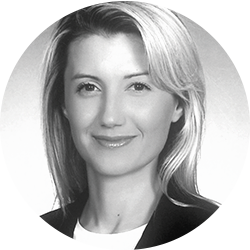
Aylin Kiliç, MD
Coffee, Chocolate, and Chats
Being in a good mood on surgery days is as important to me as it is to any surgeon. Thus, a good night’s sleep and a wholesome breakfast are two of my musts. I have never been a surgeon who arrives at the OR at the last minute and starts a procedure in a hurry. Rather, I wake up well in advance, take my time having breakfast, and get to the OR early to speak with my team members before surgery. Their moods are as important to me as mine is.
One of our greatest team rituals is having Turkish coffee together. Preparing Turkish coffee is a ritual in itself: It does not come out of a machine, but rather brews slowly on a fire. In my experience, the conversations that accompany Turkish coffee taste as good as the beverage itself. A piece of chocolate on the side is the recipe for perfection—and my definition of a lucky charm.

As a private eye hospital, our center is lucky to have a team of anesthesiologists who are experts in anesthesia for ocular surgeries. To calm elderly cataract patients, our anesthesiologist, Pulatkan Umran, holds their hands and talks with them. Her communication with patients is subtle and, at times, fun.
The success of a surgery is directly related to the harmony we attain with the patient. Patients receiving topical anesthesia must be informed continuously of their situation. We use this constant communication as a way to lift everyone’s spirits, and we all relish this ritual. Working with anesthesiologists who enjoy their jobs as much as I do is necessary for an enjoyable surgical environment.
As a high-volume surgical team, we usually use two separate ORs. While I perform surgery in one room, the next patient is prepared in the other. The preparations are done in a relaxed environment, and our nurses are not under pressure.
Music plays a vital role in my life, and I find it to be a necessity in the OR. While operating, I listen to many types of music, including Turkish and world music. The patient’s wound site is sterilized, the music is set up before I go into the room, and then the procedure begins.

Courtesy of Aylin Kiliç, MD
The contribution of assistants and nurses to surgery cannot be denied. These individuals play a crucial role in the OR by supporting the patient, fulfilling their responsibilities, and helping to solve any problems that may arise. Their ability to work efficiently depends on their experience and mood. One factor that adds to their efficiency is guidance from the doctor they work with in constant communication and harmony. By talking and getting to know each other better as we work together, we get to a point where we can communicate without words, which is rewarding for the doctor. Throwing some humor into the mix also adds spice to the team’s energy, making everything more fun.
Overall, I think my luckiest charm is my morning chat with our anesthesia team, complete with Turkish coffee and chocolate. This ritual, which we engage in at the start of every week, sets a positive tone for the coming days. Thereafter, Dr. Umran’s touch and communication with patients is another encouraging factor. Last but not least is music—without it, I feel like something is missing from the OR.

Erik L. Mertens, MD, FEBOphth
Music in the OR
I find it extremely important to create a relaxing atmosphere for my surgical patients. This starts with their preparation in the waiting room. My patient coordinators are well trained in relieving tension, and they strive to reduce patients’ stress and build their confidence. As a result of these efforts, we have found that our patients are much more relaxed when entering the OR and that the surgical experience as a whole benefits greatly. To continue this trend, my playlist during surgery consists mainly of lounge music and relaxing songs. For a selection of my favorites, see My OR Playlist.
My OR Playlist
“I’m Okay” - Sarah Bettens
“Heading For A Fall” - Vaya con Dios
“These Days” - Ozark Henry
“Life in Technicolor”- Coldplay
“Memory Lane” - Sweet Coffee
“Breakwater” - Artstoner Justin Le Mar
“Strange Entity” - Oscar and the Wolfe
“No Sound But The Wind” - The Editors
“The Architect” - dEus
“Helen” - 4Tunes
“Perfect Day” - Beatkonexion
“Rainy Days in Shanghai” - Ra-Qi Gong
“Aperitif” - Eddie Silverton
“Do It To Me” - Moko Jumbies
“Fall” - Melounge
“Green Mile” - Esowellnic
“Life Is on the Sea” - Bebo Best
“On Air” - Beatkonexion
“Searching You” - Second Floor
“A Volta” - Arsenal
SURGICAL DRESS CODE
Quresh B. Maskati, MS, DOMS, FCPS, FICS
Our patients are admitted at our day care surgery center an hour before their surgery. They are all encouraged to have a face wash at the center, and they are given a fresh set of loose-fitting garments. Just before being taken to the OR, they are given a comfortable and clean gown to wear and a sterile cap to cover their hair.
The OR staff—the nurses, attendants, and doctors—all change from their street clothes into color-coded clean clothes provided by the center. The scrub nurse and the operating surgeon and assistant don autoclaved cloth reusable gowns and sterile powder-free gloves prior to surgery.
This protocol is a key component in our pursuit to provide safe and sterile surgery for every patient we treat.

Inder Paul Singh, MD
Music in Medicine
As a member of the world music band Funkadesi (pictured above), I have come to appreciate the ability music has to bring people together. Our band includes members from different areas of the world and of a variety of religions, socioeconomic backgrounds, and educational statuses. Interestingly, we do not see these differences because music is the vehicle that brings us together and helps us appreciate what we have in common.
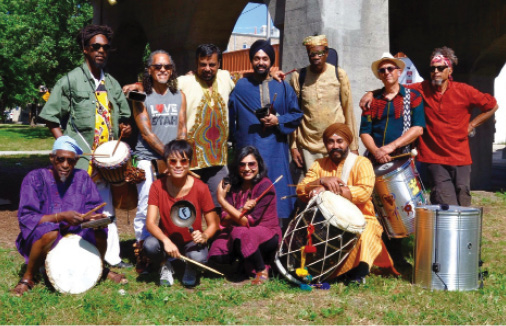
Courtesy of Inder Paul Singh, MD
In the OR, I believe that music helps to create and foster that same commonality. It enables me and the staff to work in better harmony, and, more important, it helps build common ground with patients. Just the other day, a patient was extremely stressed despite intravenous sedation, so I asked him what kind of music he liked. He named Stevie Wonder, so I told the tech to play “Superstition.” About 10 seconds into the song, the patient was calm. The music served as a way for him to focus on something he was familiar with, and it took him to a place that allowed him to relax—and, in turn, it did the same for me.

Courtesy of Inder Paul Singh, MD
Because I have such a broad appreciation of music, my playlist varies from day to day and surgery to surgery. If I am doing a longer case—for example, a glaucoma procedure—I may play reggae tunes, by artists such as Bob Marley, to keep me relaxed, or lounge music, by the Thievery Corporation, for example. If I have a busy day of standard cataract or minimally invasive glaucoma surgery cases, I might play some Top 40 tunes from the 1980s or ‘90s synthpop music to keep me moving. Of course, there are days when we all just want to jam out, and, on those days, I play ‘70s classic rock. Sometimes I am in the mood for singer-songwriter music, especially when I am about to do a tough case, so I will put on James Taylor or Jack Johnson; these artists put me in a nice fluid zone. Basically, there is music for every emotion.
Listening to music can enhance or suppress feelings. If I am happy, music adds to my happiness. If I am sad, music reduces my sadness. If I am stressed or angry, music gives me hope and calms me down. Music communicates something that cannot be put into words—a recognition that another person feels what you feel and has a mutual understanding for any given situation. That is the power of music. In the OR, it truly helps me focus and, for some reason, helps keep my mind from overthinking or wandering.
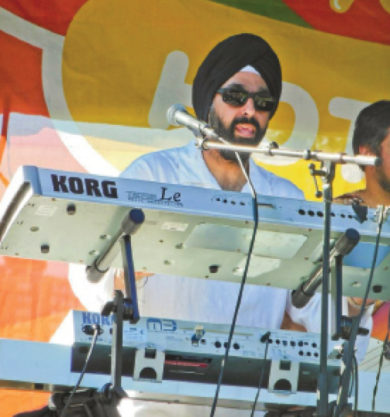
Courtesy of Inder Paul Singh, MD
Music has been used in medicine for thousands of years, although modern medicine is just starting to understand its effects. Research has shown that if you play classical music, such as Mozart, with a certain slow beat, the listener will adapt his or her heartbeat to the beat of the music. Recently, researchers found that patients who listened to music before, during, or after surgery had less pain, took less pain medication, and were less anxious after surgery.1 The effects lasted more than 4 hours after the operation and were greater for patients who grooved out before their surgeries. That is the power of music!
1. Hole J, Hirsch M, Ball E, Meads C. Music as an aid for postoperative recovery in adults: a systematic review and meta-analysis. Lancet. 2015;386(10004):1659-1671.
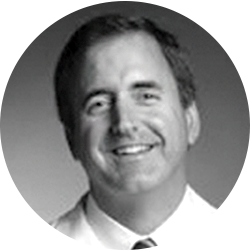
Vance Thompson, MD
My Surgical Priorities
I do not know if my OR ritual will be enlightening for readers, but it sure works for me. My priorities center around ensuring good connections with the people I operate on and work with, maintaining the ambiance that is created by nonsurgical elements such as music, and ensuring that the proper data is displayed for me to refer to at a moment’s notice.
Connections. For me, OR time is some of the most relaxing, as I feel at peace in this setting. I perform a high volume of surgery, and, given that I spend a lot of time in the OR, I love setting it up in a joyful way. My routine includes developing a connection with every person I work with. I make sure to say good morning, use eye contact, and share a smile with everyone I encounter in our ASC. Although I wear a mask while operating, I feel it is important to try to smile with my eyes in order to set and maintain a positive tone.
Of equal importance to me is the bond I form with my patients. My connection with the patient starts in the clinic, and I aim to continue to develop this throughout the surgical experience. Performing surgery on a fellow human is an intimate act, and it deserves the respect implied by basic human communications and interactions.
Music. I love playing music in the OR. I believe that music relaxes the patient and the team and creates an enjoyable ambiance for me. I am a drummer, and I enjoy all types of music, but during surgery I try not to listen to music that would make me want to drum. I love romantic or contemporary piano music, so that is primarily what I listen to while operating.
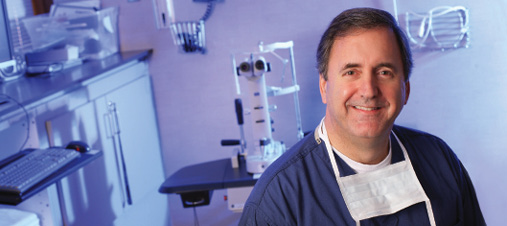
I take surgery very seriously. There are times when my eyes get misty in the OR thinking about the honor of having the patient’s trust and the privilege of working with the people around me, whom I consider my work family. The gratitude I feel for the ability to do what we do inside a fellow human’s eye can be overwhelming. Thus, feeling a connection to those around me and to the music being played is important to my ritual.
Data display. Finally, having the appropriate data displayed in the OR is important to me. I approach every cataract surgery as a refractive surgery, and, thus, I prefer to have the patient’s topography, keratometry (K) readings, biometry data, and examination sheet posted and clearly visible. I first perform a quick review of the exam sheet for any issues I want to be prepared for, and then I reexamine the patient’s topography, K readings, and biometry data. I want to remind myself, for instance, if I am about to operate on a short eye. For nontoric IOL cases, I operate on the steep axis to get whatever astigmatism reduction I can get from the incision location, so I want to make sure I am on target for that.
We are blessed to be in the OR and to do what we do. Connecting with all those involved in the case, using music to set the ambiance, and having easy access to necessary data are key elements of my routine for every surgery.

